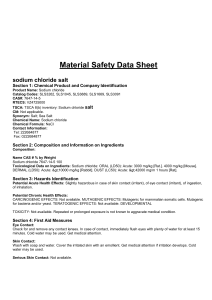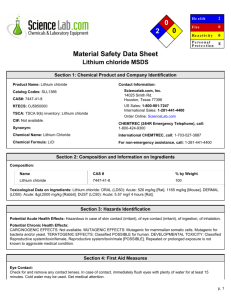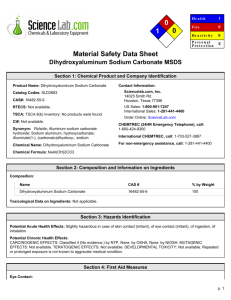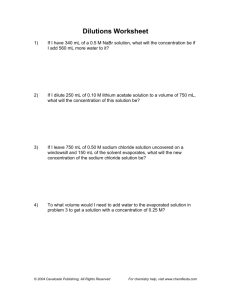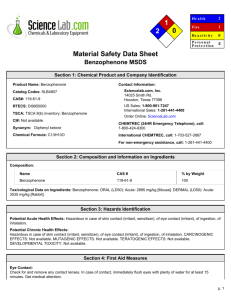MSDS for Sodium chloride
advertisement
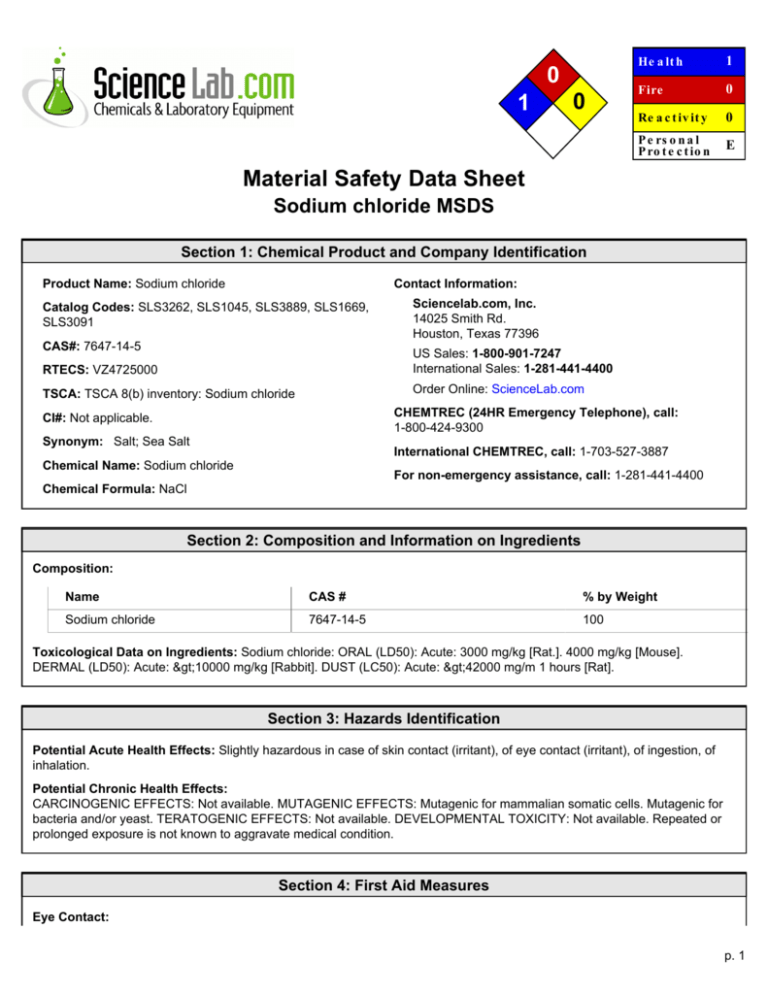
0 1 0 He a lt h 1 Fire 0 Re a c t iv it y 0 P e rs o n a l P ro t e c t io n E Material Safety Data Sheet Sodium chloride MSDS Section 1: Chemical Product and Company Identification Product Name: Sodium chloride Contact Information: Catalog Codes: SLS3262, SLS1045, SLS3889, SLS1669, SLS3091 CAS#: 7647-14-5 Sciencelab.com, Inc. 14025 Smith Rd. Houston, Texas 77396 RTECS: VZ4725000 US Sales: 1-800-901-7247 International Sales: 1-281-441-4400 TSCA: TSCA 8(b) inventory: Sodium chloride Order Online: ScienceLab.com CHEMTREC (24HR Emergency Telephone), call: 1-800-424-9300 CI#: Not applicable. Synonym: Salt; Sea Salt International CHEMTREC, call: 1-703-527-3887 Chemical Name: Sodium chloride For non-emergency assistance, call: 1-281-441-4400 Chemical Formula: NaCl Section 2: Composition and Information on Ingredients Composition: Name CAS # % by Weight Sodium chloride 7647-14-5 100 Toxicological Data on Ingredients: Sodium chloride: ORAL (LD50): Acute: 3000 mg/kg [Rat.]. 4000 mg/kg [Mouse]. DERMAL (LD50): Acute: >10000 mg/kg [Rabbit]. DUST (LC50): Acute: >42000 mg/m 1 hours [Rat]. Section 3: Hazards Identification Potential Acute Health Effects: Slightly hazardous in case of skin contact (irritant), of eye contact (irritant), of ingestion, of inhalation. Potential Chronic Health Effects: CARCINOGENIC EFFECTS: Not available. MUTAGENIC EFFECTS: Mutagenic for mammalian somatic cells. Mutagenic for bacteria and/or yeast. TERATOGENIC EFFECTS: Not available. DEVELOPMENTAL TOXICITY: Not available. Repeated or prolonged exposure is not known to aggravate medical condition. Section 4: First Aid Measures Eye Contact: p. 1 Check for and remove any contact lenses. In case of contact, immediately flush eyes with plenty of water for at least 15 minutes. Cold water may be used. Get medical attention. Skin Contact: Wash with soap and water. Cover the irritated skin with an emollient. Get medical attention if irritation develops. Cold water may be used. Serious Skin Contact: Not available. Inhalation: If inhaled, remove to fresh air. If not breathing, give artificial respiration. If breathing is difficult, give oxygen. Get medical attention if symptoms appear. Serious Inhalation: Not available. Ingestion: Do NOT induce vomiting unless directed to do so by medical personnel. Never give anything by mouth to an unconscious person. Loosen tight clothing such as a collar, tie, belt or waistband. Get medical attention if symptoms appear. Serious Ingestion: Not available. Section 5: Fire and Explosion Data Flammability of the Product: Non-flammable. Auto-Ignition Temperature: Not applicable. Flash Points: Not applicable. Flammable Limits: Not applicable. Products of Combustion: Not available. Fire Hazards in Presence of Various Substances: Not applicable. Explosion Hazards in Presence of Various Substances: Risks of explosion of the product in presence of mechanical impact: Not available. Risks of explosion of the product in presence of static discharge: Not available. Fire Fighting Media and Instructions: Not applicable. Special Remarks on Fire Hazards: When heated to decomposition it emits toxic fumes. Special Remarks on Explosion Hazards: Electrolysis of sodium chloride in presence of nitrogenous compounds to produce chlorine may lead to formation of explosive nitrogen trichloride. Potentially explosive reaction with dichloromaleic anhydride + urea. Section 6: Accidental Release Measures Small Spill: Use appropriate tools to put the spilled solid in a convenient waste disposal container. Finish cleaning by spreading water on the contaminated surface and dispose of according to local and regional authority requirements. Large Spill: Use a shovel to put the material into a convenient waste disposal container. Finish cleaning by spreading water on the contaminated surface and allow to evacuate through the sanitary system. Section 7: Handling and Storage Precautions: Keep locked up.. Do not ingest. Do not breathe dust. Avoid contact with eyes. Wear suitable protective clothing. If ingested, seek medical advice immediately and show the container or the label. Keep away from incompatibles such as oxidizing agents, acids. p. 2 Storage: Keep container tightly closed. Keep container in a cool, well-ventilated area. Hygroscopic Section 8: Exposure Controls/Personal Protection Engineering Controls: Use process enclosures, local exhaust ventilation, or other engineering controls to keep airborne levels below recommended exposure limits. If user operations generate dust, fume or mist, use ventilation to keep exposure to airborne contaminants below the exposure limit. Personal Protection: Splash goggles. Lab coat. Dust respirator. Be sure to use an approved/certified respirator or equivalent. Gloves. Personal Protection in Case of a Large Spill: Splash goggles. Full suit. Dust respirator. Boots. Gloves. A self contained breathing apparatus should be used to avoid inhalation of the product. Suggested protective clothing might not be sufficient; consult a specialist BEFORE handling this product. Exposure Limits: Not available. Section 9: Physical and Chemical Properties Physical state and appearance: Solid. (Solid crystalline powder.) Odor: Slight. Taste: Saline. Molecular Weight: 58.44 g/mole Color: White. pH (1% soln/water): 7 [Neutral.] Boiling Point: 1413°C (2575.4°F) Melting Point: 801°C (1473.8°F) Critical Temperature: Not available. Specific Gravity: 2.165 (Water = 1) Vapor Pressure: Not applicable. Vapor Density: Not available. Volatility: Not available. Odor Threshold: Not available. Water/Oil Dist. Coeff.: Not available. Ionicity (in Water): Not available. Dispersion Properties: See solubility in water. Solubility: Easily soluble in cold water, hot water. Soluble in glycerol, and ammonia. Very slightly soluble in alcohol. Insoluble in Hydrochloric Acid. Section 10: Stability and Reactivity Data Stability: The product is stable. p. 3 Instability Temperature: Not available. Conditions of Instability: Incompatible materials, high temperatures. Incompatibility with various substances: Reactive with oxidizing agents, metals, acids. Corrosivity: Not considered to be corrosive for metals and glass. Special Remarks on Reactivity: Hygroscopic. Reacts with most nonnoble metals such as iron or steel, building materials (such as cement) Sodium chloride is rapidly attacked by bromine trifluoride. Violent reaction with lithium. Special Remarks on Corrosivity: Not available. Polymerization: Will not occur. Section 11: Toxicological Information Routes of Entry: Inhalation. Ingestion. Toxicity to Animals: WARNING: THE LC50 VALUES HEREUNDER ARE ESTIMATED ON THE BASIS OF A 4-HOUR EXPOSURE. Acute oral toxicity (LD50): 3000 mg/kg [Rat.]. Acute dermal toxicity (LD50): >10000 mg/kg [Rabbit]. Acute toxicity of the dust (LC50): >42000 mg/m3 1 hours [Rat]. Chronic Effects on Humans: MUTAGENIC EFFECTS: Mutagenic for mammalian somatic cells. Mutagenic for bacteria and/ or yeast. Other Toxic Effects on Humans: Slightly hazardous in case of skin contact (irritant), of ingestion, of inhalation. Special Remarks on Toxicity to Animals: Lowest Published Lethal Dose (LDL) [Man] - Route: Oral; Dose: 1000 mg/kg Special Remarks on Chronic Effects on Humans: Causes adverse reproductive effects in humans (fetotoxicity, abortion, ) by intraplacental route. High intake of sodium chloride, whether from occupational exposure or in the diet, may increase risk of TOXEMIA OF PREGNANCY in susceptible women (Bishop, 1978). Hypertonic sodium chloride solutions have been used to induce abortion in late pregnancy by direct infusion into the uterus (Brown et al, 1972), but this route of administration is not relevant to occupational exposures. May cause adverse reproductive effects and birth defects in animals, particularly rats and mice (fetotoxicity, abortion, musculoskeletal abnormalities, and maternal effects (effects on ovaries, fallopian tubes) by oral, intraperitoneal, intraplacental, intrauterine, parenteral, and subcutaneous routes. While sodium chloride has been used as a negative control n some reproductive studies, it has also been used as an example that almost any chemical can cause birth defects in experimental animals if studied under the right conditions (Nishimura & Miyamoto, 1969). In experimental animals, sodium chloride has caused delayed effects on newborns, has been fetotoxic, and has caused birth defects and abortions in rats and mice (RTECS, 1997). May affect genetic material (mutagenic) Special Remarks on other Toxic Effects on Humans: Acute Potential Health Effects: Skin: May cause skin irritation. Eyes: Causes eye irritation. Ingestion: Ingestion of large quantities can irritate the stomach (as in overuse of salt tablets) with nausea and vomiting. May affect behavior (muscle spasicity/contraction, somnolence), sense organs, metabolism, and cardiovascular system. Continued exposure may produce dehydration, internal organ congestion, and coma. Inhalation: Material is irritating to mucous membranes and upper respiratory tract. Section 12: Ecological Information Ecotoxicity: Not available. BOD5 and COD: Not available. Products of Biodegradation: Possibly hazardous short term degradation products are not likely. However, long term degradation products may arise. Toxicity of the Products of Biodegradation: The product itself and its products of degradation are not toxic. p. 4 Special Remarks on the Products of Biodegradation: Not available. Section 13: Disposal Considerations Waste Disposal: Waste must be disposed of in accordance with federal, state and local environmental control regulations. Section 14: Transport Information DOT Classification: Not a DOT controlled material (United States). Identification: Not applicable. Special Provisions for Transport: Not applicable. Section 15: Other Regulatory Information Federal and State Regulations: TSCA 8(b) inventory: Sodium chloride Other Regulations: EINECS: This product is on the European Inventory of Existing Commercial Chemical Substances. Other Classifications: WHMIS (Canada): Not controlled under WHMIS (Canada). DSCL (EEC): R40- Possible risks of irreversible effects. S24/25- Avoid contact with skin and eyes. HMIS (U.S.A.): Health Hazard: 1 Fire Hazard: 0 Reactivity: 0 Personal Protection: E National Fire Protection Association (U.S.A.): Health: 1 Flammability: 0 Reactivity: 0 Specific hazard: Protective Equipment: Gloves. Lab coat. Dust respirator. Be sure to use an approved/certified respirator or equivalent. Splash goggles. Section 16: Other Information References: -Hawley, G.G.. The Condensed Chemical Dictionary, 11e ed., New York N.Y., Van Nostrand Reinold, 1987. -SAX, N.I. Dangerous Properties of Indutrial Materials. Toronto, Van Nostrand Reinold, 6e ed. 1984. -The Sigma-Aldrich Library of Chemical Safety Data, Edition II. Other Special Considerations: Not available. Created: 10/11/2005 12:33 PM p. 5 Last Updated: 05/21/2013 12:00 PM The information above is believed to be accurate and represents the best information currently available to us. However, we make no warranty of merchantability or any other warranty, express or implied, with respect to such information, and we assume no liability resulting from its use. Users should make their own investigations to determine the suitability of the information for their particular purposes. In no event shall ScienceLab.com be liable for any claims, losses, or damages of any third party or for lost profits or any special, indirect, incidental, consequential or exemplary damages, howsoever arising, even if ScienceLab.com has been advised of the possibility of such damages. p. 6
